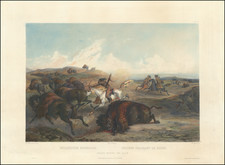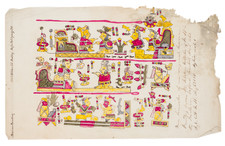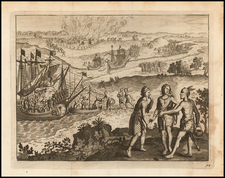Dramatic Bison Hunting Scene in the Upper Missouri
A fine hand-colored print by Karl Bodmer depicting Native Americans hunting bison near Fort Union, near the present-day North Dakota-Montana border. This view was originally issued as Tableau 31 of Prince Maximilian of Wied-Neuwied's monumental pictorial work of the American West, Reise in das innere Nord-America in den Jaren 1832 bis 1834, or Travels in the Interior of North America, 1832-34, which was illustrated with aquatint engravings after Karl Bodmer's magnificent original art work. The work included detailed and accurate depictions of the landscapes, peoples, and cultures encountered by Bodmer during his journey, and is considered an important record of the American West during this time period.
According to Brandon K. Ruud, Bodmer likely based this scene on both his experience witnessing a bison hunt near Fort Union in the Upper Missouri as well as the works of earlier artists such as George Catlin and Peter Rindisbacher:
Maximilian and Bodmer participated in a buffalo hunt near Fort Union on 11 October 1833. The two men went out with a group of hunters from the post in a routine search for game; their combined efforts were successful, and that night all dined on roast buffalo. Bodmer made a number of buffalo studies, either while observing the herd and wounded and dead animals or shortly after the hunt... Tableau 31 mimics Maximilian's narrative in many ways, showing a group of hunters on the prairie with the foreground hunting within feet of his prey... it is not surprising that Tableau 31 contains many elements found in Catlin's and Rindisbacher's interpretations: the scattering of bison across rolling hills, often with a number of Native Americans on horseback in pursuit of them; a dying buffalo in the foreground; the bison and horses leaping off all fours; and the position of the Native American attacking the buffalo and his proximity to it.
Maximilian’s American travel account first appeared in German (1839-41), followed by a French translation in 1840-43 and an English edition in 1843. The Paris-issued pictorial atlas contained eighty-one aquatint plates (48 "imperial" folios and 33 smaller "vignette" plates often called quarto in size), engraved and etched on metal sheets, after paintings by Karl Bodmer, and which accompanied all three editions. The plates are outstanding authentic depictions of the western plains and Native Americans by a highly skilled European artist. Bodmer avoided romanticizing his subjects, and attempted to record the people and places he encountered as true to life as possible.
The present print is a 1922 restrike from the original plate done in Leipzig by Schmidt & Guenther, issued on thicker vellum paper than the 19th century examples.










![[ Native American about to Murder A Frenchman in a Dugout Canoe ] Petri Gambie Galli Caedes](https://storage.googleapis.com/raremaps/img/small/97871.jpg)
![[St. Augustine, Florida] Oppidorum apud Floridenses structura. XXX](https://storage.googleapis.com/raremaps/img/small/98035.jpg)


![[ Florida Indians - Destroying the Enemy's Towns By Night ] Hostium oppida noctu incendendi ratio. XXXI.er absagen](https://storage.googleapis.com/raremaps/img/small/97385.jpg)
![[Columbus Discovering the Americas]](https://storage.googleapis.com/raremaps/img/small/82203.jpg)